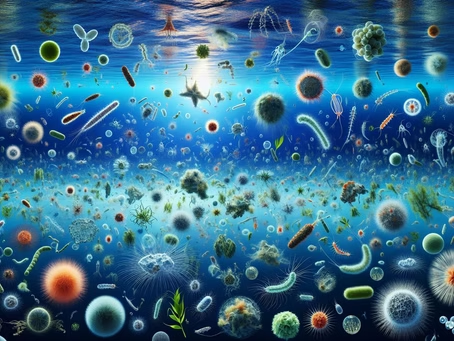The Overlooked Guardians of the Ocean
Marine microorganisms are often overlooked, yet they play a vital role in sustaining the ocean’s health and balance. From the tiniest viruses to complex microalgae, these invisible organisms form the foundation of marine ecosystems. Their work includes nutrient cycling, climate regulation, and supporting food webs that sustain life across the planet. This article explores their diversity, functions, and significance as the ocean’s unsung heroes.
Unveiling Microbial Diversity
The diversity of marine microbes is staggering, surpassing even the number of grains of sand on Earth’s beaches. Each group has a unique ecological niche:
- Viruses – the most abundant, shaping microbial populations and nutrient cycles.
- Bacteria – decomposers and recyclers that regulate ocean chemistry.
- Archaea – thriving in extreme conditions like deep-sea vents.
- Microalgae – primary producers forming the base of the marine food web.
This diversity ensures resilience and stability, enabling marine ecosystems to withstand environmental change.
Roles and Relationships
Marine microbes act like specialized workers in an underwater economy:
- Photosynthesizers capture sunlight, producing oxygen and organic matter.
- Decomposers recycle nutrients from dead organisms.
- Symbionts form partnerships with corals, fish, and invertebrates, enhancing survival and resilience.
Together, these interactions sustain the delicate balance of ocean ecosystems.
Microalgae: The Ocean’s Power Plants
Microalgae drive photosynthesis beneath the waves, producing over half of Earth’s oxygen. They not only feed marine life but also absorb carbon dioxide, contributing to climate regulation. However, excessive growth can trigger algal blooms, which may suffocate ecosystems or release toxins, underscoring the need for balance in their populations.
Bacteria and Archaea: Nature’s Cleanup Crew
Bacteria and archaea are the recyclers of the ocean. They break down organic matter, fix nitrogen, and even help degrade pollutants like oil and plastic. Without their constant work, oceanic nutrient cycles would collapse, threatening marine biodiversity and food security.
Viruses: Shaping Life Beneath the Waves
Marine viruses are more than pathogens. They regulate microbial populations, drive nutrient recycling through cell lysis, and even contribute to genetic diversity. Some giant viruses blur the line between simple and complex life, hinting at unexplored evolutionary pathways.
Life in Extreme Environments
In the deep sea, microbes thrive in crushing pressure and total darkness. Extremophiles living near hydrothermal vents use chemosynthesis to support unique ecosystems of tube worms, shrimp, and fish. These microbes not only expand our understanding of life’s limits but also offer potential applications in medicine and biotechnology.
Climate Change and Microbial Communities
Warming oceans and acidification disrupt microbial populations, altering food webs and nutrient cycles. While some microbes adapt or even thrive, others decline, causing ripple effects across ecosystems. Predictive science helps us understand these shifts and informs conservation strategies.
Conservation and Human Connection
Protecting microbial diversity is crucial for ocean resilience. Marine Protected Areas, sustainable fishing, pollution reduction, and innovative research safeguard these microscopic custodians. Their influence reaches humans directly—microbes impact seafood quality, inspire medical discoveries, and support global climate stability.
Conclusion
Marine microorganisms are the invisible guardians of the ocean. From fueling food webs to regulating the carbon cycle, they are indispensable to both marine and human life. Safeguarding them means safeguarding the future of our oceans and the health of the planet itself.
Frequently Asked Questions
What are marine microorganisms?
Tiny life forms including bacteria, archaea, viruses, fungi, and microalgae that regulate ocean systems.
How do they affect climate?
Microalgae absorb carbon dioxide while bacteria and viruses recycle nutrients that influence global cycles.
Are marine viruses harmful?
Not always—many regulate microbial populations and support nutrient cycling in marine ecosystems.
Why are deep-sea microbes important?
They thrive in extremes, support unique ecosystems, and provide insights for biotechnology and medicine.
How can we protect microbial diversity?
Through marine protected areas, sustainable practices, pollution reduction, and ongoing scientific research.

